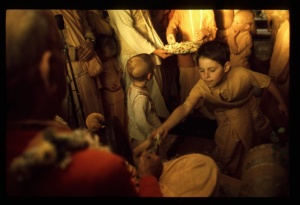CC Adi 16.31 (1975): Difference between revisions
(Vanibot #0027: CCMirror - Mirror CC's 1996 edition to form a basis for 1975) |
(Vanibot #0020: VersionCompareLinker - added a link to the Version Compare feature) |
||
| Line 2: | Line 2: | ||
<div style="float:left">'''[[Sri Caitanya-caritamrta (1975)|Śrī Caitanya-caritāmṛta (1975)]] - [[CC Adi (1975)|Ādi-līlā]] - [[CC Adi 16 (1975)|Chapter 16: The Pastimes of the Lord in His Childhood and Youth]]'''</div> | <div style="float:left">'''[[Sri Caitanya-caritamrta (1975)|Śrī Caitanya-caritāmṛta (1975)]] - [[CC Adi (1975)|Ādi-līlā]] - [[CC Adi 16 (1975)|Chapter 16: The Pastimes of the Lord in His Childhood and Youth]]'''</div> | ||
<div style="float:right">[[File:Go-previous.png|link=CC Adi 16.30 (1975)|Ādi-līlā 16.30]] '''[[CC Adi 16.30 (1975)|Ādi-līlā 16.30]] - [[CC Adi 16.32 (1975)|Ādi-līlā 16.32]]''' [[File:Go-next.png|link=CC Adi 16.32 (1975)|Ādi-līlā 16.32]]</div> | <div style="float:right">[[File:Go-previous.png|link=CC Adi 16.30 (1975)|Ādi-līlā 16.30]] '''[[CC Adi 16.30 (1975)|Ādi-līlā 16.30]] - [[CC Adi 16.32 (1975)|Ādi-līlā 16.32]]''' [[File:Go-next.png|link=CC Adi 16.32 (1975)|Ādi-līlā 16.32]]</div> | ||
{{CompareVersions|CC|Adi 16.31|CC 1975|CC 1996}} | |||
{{RandomImage}} | {{RandomImage}} | ||
==== TEXT 31 ==== | ==== TEXT 31 ==== | ||
| Line 18: | Line 17: | ||
<div class="synonyms"> | <div class="synonyms"> | ||
vyākaraṇa—grammar; paḍāha—You teach; nimāñi paṇḍita—Nimāi Paṇḍita; tomāra—Your; nāma—name; bālya-śāstre—in grammar, which is considered a study for boys; loke—the people in general; tomāra—of You; kahe—declare; guṇa-grāma—very | vyākaraṇa—grammar; paḍāha—You teach; nimāñi paṇḍita—Nimāi Paṇḍita; tomāra—Your; nāma—name; bālya-śāstre—in grammar, which is considered a study for boys; loke—the people in general; tomāra—of You; kahe—declare; guṇa-grāma—very qualified. | ||
</div> | </div> | ||
| Line 25: | Line 24: | ||
<div class="translation"> | <div class="translation"> | ||
"I understand that You are a teacher of grammar," he said, "and that Your name is Nimāi Paṇḍita. People speak very highly of Your teaching of beginners' grammar. | |||
</div> | </div> | ||
| Line 32: | Line 31: | ||
<div class="purport"> | <div class="purport"> | ||
Formerly Sanskrit schools first taught grammar very thoroughly, and this system continues even now. A student was supposed to study grammar carefully for twelve years in the beginning of his life, because if one is expert in the grammar of the Sanskrit language, all the śāstras are open to him. Śrī Caitanya Mahāprabhu was famous for teaching grammar to students, and therefore Keśava Kāśmīrī first referred to His position as a teacher of grammar. | Formerly Sanskrit schools first taught grammar very thoroughly, and this system continues even now. A student was supposed to study grammar carefully for twelve years in the beginning of his life, because if one is expert in the grammar of the Sanskrit language, all the śāstras are open to him. Śrī Caitanya Mahāprabhu was famous for teaching grammar to students, and therefore Keśava Kāśmīrī first referred to His position as a teacher of grammar. He was very proud of his literary career; he was far above the first lessons of grammar, and so he thought the position of Nimāi Paṇḍita not at all comparable to his own. | ||
</div> | </div> | ||
Latest revision as of 15:42, 26 January 2020

A.C. Bhaktivedanta Swami Prabhupada
TEXT 31
- vyākaraṇa paḍāha, nimāñi paṇḍita tomāra nāma
- bālya-śāstre loke tomāra kahe guṇa-grāma
SYNONYMS
vyākaraṇa—grammar; paḍāha—You teach; nimāñi paṇḍita—Nimāi Paṇḍita; tomāra—Your; nāma—name; bālya-śāstre—in grammar, which is considered a study for boys; loke—the people in general; tomāra—of You; kahe—declare; guṇa-grāma—very qualified.
TRANSLATION
"I understand that You are a teacher of grammar," he said, "and that Your name is Nimāi Paṇḍita. People speak very highly of Your teaching of beginners' grammar.
PURPORT
Formerly Sanskrit schools first taught grammar very thoroughly, and this system continues even now. A student was supposed to study grammar carefully for twelve years in the beginning of his life, because if one is expert in the grammar of the Sanskrit language, all the śāstras are open to him. Śrī Caitanya Mahāprabhu was famous for teaching grammar to students, and therefore Keśava Kāśmīrī first referred to His position as a teacher of grammar. He was very proud of his literary career; he was far above the first lessons of grammar, and so he thought the position of Nimāi Paṇḍita not at all comparable to his own.